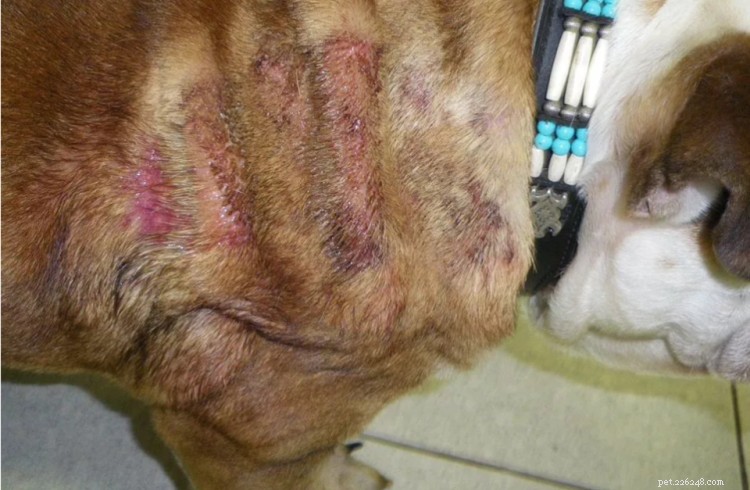Als je harige vriend zich ongemakkelijk voelt of veel tijd jeukt en aan zijn lichaam krabt, kan hij een schimmelinfectie hebben. Schimmelinfecties bij honden zijn een veelvoorkomende aandoening die overal op de huid kan voorkomen en hardnekkig is om te behandelen.
In dit bericht leert u hoe u de symptomen van een schimmelinfectie bij honden kunt herkennen, hoe u de aandoening kunt behandelen en hoe u deze kunt onderscheiden van bacteriële infecties en allergische reacties.
Pro-tip: Dierenverzekeringsclaims voor huidaandoeningen kosten doorgaans minder dan andere ziekten, omdat de behandelingen minder ingrijpend zijn. Uw pup kan echter voortdurende medicatie nodig hebben om de schimmelinfectie onder controle te houden en jeuk te verlichten, wat nogal duur kan zijn zonder een huisdierenverzekering die dekking biedt voor geneesmiddelen op recept.
 (Bron afbeelding:Paw Culture)
(Bron afbeelding:Paw Culture)
Gistinfectie (of schimmeldermatitis) is een inflammatoire huidaandoening die vaak voorkomt bij honden . Gistorganismen zijn altijd aanwezig op honden als onderdeel van de normale lichaamsflora, maar een schimmelinfectie treedt op wanneer er een overmatige hoeveelheid gist in een bepaald gebied is - meestal de oren, huidplooien of tussen de voetzolen.
Meestal treden schimmelinfecties bij honden op als gevolg van een afzonderlijk, onderliggend probleem. Het komt bijvoorbeeld vaker voor bij puppy's met een gecompromitteerd immuunsysteem, omgevingsallergieën of voedselallergieën - vooral als ze antibiotica of steroïden gebruiken.
Hoewel antibiotica geen gist veroorzaken, kan langdurig gebruik de aanwezigheid van gezonde flora verminderen die de niveaus onder controle houdt, wat leidt tot overgroei van gist. Steroïden kunnen ook een negatief effect hebben op het immuunsysteem van uw huisdier, waardoor de gist kan overgroeien.
Heet of vochtig weer, een bacteriële infectie en onderliggende huidziekte zoals atopische dermatitis, zijn ook risicofactoren die kunnen leiden tot schimmelinfectie bij honden.
Een schimmelinfectie is niet het enige waardoor uw harige vriend meer dan normaal kan krabben. Jeukende symptomen kunnen wijzen op iets heel anders, zoals:
Bacteriële huidinfecties veroorzaken ontstekingen waardoor uw hond roodheid, huiduitslag, korsten en puisten op de huid kan krijgen als gevolg van toxines die door bacteriën worden geproduceerd. Dit kan gebeuren als:
Teken, vlooien, hormonale onevenwichtigheden, erfelijkheid en bepaalde medicijnen kunnen ook het risico verhogen dat uw huisdier een bacteriële huidinfectie zoals pyodermie ontwikkelt.
Een andere veel voorkomende oorzaak van jeukende huid bij honden is allergieën. Terwijl mensen kunnen niezen tijdens een milde allergische reactie, hebben honden de neiging om een jeukende huid te krijgen. Voedselallergieën kunnen zich op elk moment in het leven ontwikkelen, wat betekent dat uw pup allergisch kan worden voor voedsel dat hij of zij regelmatig at en genoot.
Omgevingsfactoren zoals schimmel, huisstofmijt en pollen kunnen ook verantwoordelijk zijn voor de aanhoudende jeuk van uw hond, vaak met intensiever krabben op bepaalde tijden van het jaar.
Eigenaren van gezelschapsdieren zullen het verschil tussen een schimmelinfectie, bacteriële infectie en allergische reactie thuis niet kunnen zien, dus de beste manier om te handelen is om uw pup naar de dierenarts te brengen.
Only a vet can truly determine the cause behind the constant scratching, but there are a few symptoms that may provide an indication. Unlike allergic reactions and bacterial infections, yeast infection symptoms most commonly affect specific parts of the body.
Yeast infection in the ear canal is very common in canines. In most cases, there is redness, swelling, and brown discharge, accompanied by a musty or sweet smell. Ear infections are usually very itchy, causing your pooch to rub their head or scratch their ears excessively.
You may also notice other symptoms like crusted skin on the ear flap, loss of hair around the ear, head tilting or shaking, walking in circles, loss of hearing, loss of balance, and unusual eye movement.
Yeast dermatitis can occur anywhere on a dog’s skin, especially in moist skin folds, around the face and neck, where the legs meet the body, as well as on the anus and vulva.
The infected skin might be itchy, irritated, red, flaky, or greasy, and accompanied by hair loss. If the yeast infection is chronic, the dog’s skin might become thicker and darker. Yeast infections can also affect your pup’s face or mouth, in which case there will be lots of face rubbing and itching.
You might also notice hair loss on the upper back and tail, speckles on the underbelly, rust or grayish color around the genitals, and diarrhea.
Yeast infections can also affect your pet’s paws making them itchy, red, and irritated. In some cases, this is accompanied by a brown discharge in the nail beds and hair loss. The most affected part of the paws is the underside between the pads. Pups with yeast on their paws tend to lick their paws more than usual.
Some dog breeds are more prone to yeast infections than others, based on their body features like many skin folds or genetics. Deze omvatten:
Ear yeast infections are more common in dogs with floppy ears, such as poodles, basset hounds, Labrador retrievers, and golden retrievers. Some breeds that have hair growing in the inner ear canal, such as Schnauzers, are also more prone to ear yeast infection.
 (Image source:The Spruce Pets)
(Image source:The Spruce Pets)
If you notice any of these symptoms, be sure to take your pet to the vet. He or she will perform cytology, i.e. take a sample from the pup’s infected skin or ear and review it under a microscope to confirm if there’s a yeast infection.
Your vet will also analyze the sample for other immune system issues because canines with yeast infections usually also have skin mites or bacterial infections.
The best treatment depends on the location of the infection.
Yeast infection of the outer ear canal is usually treated with antifungal drops or ointment. An infection of the middle ear will be treated with medications (injections and tablets), although additional tests and even surgery might be necessary. Your vet might also recommend a full cleaning of the pup’s ear canal. If the infection is chronic, ask about special ear cleansers you can use at home.
Ear infections can be covered by pet insurance, but it will depend on the type of pet insurance plan you have, as well as other factors like your pup's history. If you are looking for a new insurance policy but your dog has suffered from an ear infection in the past, consider a plan that covers pre-existing conditions.
Treatments for yeast infections on the skin may include medicated shampoo, topical creams, and antifungal sprays or wipes. All these products contain ingredients effective in treating yeast infections such as ketoconazole, miconazole, and chlorhexidine.
In more severe cases, if the problem persists or appears to worsen, oral antifungal medications are also prescribed. These medications should only be used under a vet’s direction.
Yeast infections can be prevented. Besides making changes and additions to your pup’s diet, you should also consider using an antifungal shampoo. Bear in mind though that for shampoo treatment to be effective, it must sit on your pet’s skin for at least 10 minutes before rinsing.
Dogs with many skin folds might need maintenance treatment to keep these areas from becoming too moist, whereas those allergic to yeast can get an allergy vaccine.
If you suspect your four-legged pal has a yeast infection, talk to your vet for a diagnosis and treatment plan that’s appropriate for your pooch.